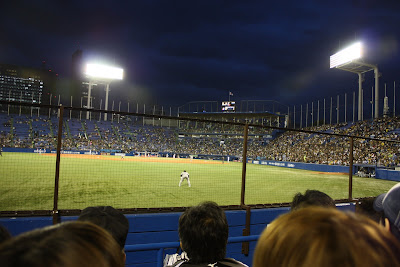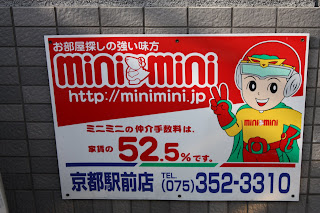Close proximity can do some crazy things to people.
After living in Japan for nearly nine months, we have become pretty comfortable with losing our American "bubble" of personal space. Whether traveling on packed trains, biking on crowded streets, or living in relatively smaller apartments, we have had to make adjustments to our traditional desire for comfortable personal space.
A few examples from our experiences on trains and with our neighbors.
Trains:This week, it rained solidly for three days straight. Normally (in the States), I respond to rainy-day streaks in a pretty consistent pattern. Day 1: I'm a little bummed because of the lack of sunshine, but it doesn't really bother me. Day 2: I start to get annoyed with being wet and with the general gloom of the sky. Day 3: I'm ready to fly to the Sahara to see blue sky and feel dry again.
Because we are so dependent on biking and walking everywhere we go, we don't have a "dry" option. When it rains, we put on a raincoat and hope our pants and shoes don't get too wet on the ride. If it's not too windy, we can use an umbrella simultaneously as we ride our bikes, but that requires some major balance and control that can sometimes be hard to manage. On Friday, it felt like we were in the middle of a hurricane because of the intense wind and heavy rain.

(After the storm finally passed)
My ride to work was awful. I literally had to hold my umbrella sideways with all the strength I could summon to keep from it pulling me up into the air like Mary Poppins. Not even halfway through my two mile trek to school, I stopped under a bridge and decided to try Plan B, taking the train instead. I turned and went a few blocks to the nearest station, parked my bike, and ran to the platform.
The problem was, EVERYONE else had the same idea. I have been on some crowded trains, but this was by far the most densely packed train I have ever attempted to ride.
If you've ever played football or seen football players practice, you may have seen their "practice sleds." They are large human-size pads attached to a very large, very heavy metal sled. When you put all your weight into them, they move back a few feet, training you to do the same when a three hundred pound lineman is in front of you.

(Some lovely gentlemen hired to shove people onto crowded trains)
No kidding, this is exactly what I had to do to get on the morning train. I turned around so my back was touching the people behind me, shoved with all my might, and created enough room for my slender frame to fit enough just inside the closing doors of the train. I would have NEVER felt comfortable doing this anywhere in the U.S., but it's a common way for people to get on crowded trains and certainly worked out for me that rainy morning.
Obviously, I've gotten over my previous need for personal space, mostly since I don't have a choice. Rachael used to have mini panic-attacks on such crowded trains and would start breathing quickly and getting flustered, but even she handles it much better now. Since everyone has to deal with the same thing, we all seem to deal with it respectfully enough and with the understanding that you do what you have to when getting from Point A to Point B.
What's interesting at school is that I find that my Japanese parents (of my students) tend to need more space in between us during our conversations than did my American parents. Sometimes I try little experiments with this both to see how they'll react and to learn about the limits of comfortable conversation in Japan. If we're standing up and I move even a couple inches toward them (since we're already 3-5 feet apart and it feels a bit distant to me), a few Japanese parents have moved back. This could be due to a whole host of factors like age, gender, teacher/parent relationships etc., but it does appear to me that Japanese people like to have an even larger personal space bubble in conversations than do those in Western societies. Maybe since they're frequently crowded and cramped in public spaces they take whatever opportunities they can to enjoy a little extra space. It's a mystery to me, but I'll keep you posted if we have any interesting updates about this in the future.
Neighbors:We've had positive, negative, and neutral interactions with our neighbors since moving here, much like neighbors do anywhere else in the world. Who out there
hasn't had a neighbor that's done something strange or unexpected we've then had to deal with? The sheer amount of people in Tokyo does make for interesting living though, since we're basically all stacked on top of and next to each other.
In our first apartment, we were happy to be on the top floor of the building with plenty of windows, space, a rooftop terrace, and a great kitchen for encouraging Rachael's passion for making amazing food. However, all the positives of that home were wiped away completely because of our nosy neighbors on the first floor who literally watched and provided commentary on our every move.
The following are some of our worst infractions, though I'm sure there were hundreds of others despite our best efforts to be good neighbors: a window was irresponsibly left open when Rachael was singing, we sinfully hung our bedspread out to dry on our clothesline (like everyone else in our new building does), our trash was out 8 or 9 minutes too early, our trash was nearly six inches away from it's proper (unmarked) spot, the front gates were not closed completely even though they neither lock or latch, and the list goes on.
These things eventually drove us crazy enough to look for a new place to live. And what did we get in return for all this insanity? A new crazy neighbor!!!
Just last week, we received this highlighted note in our mailbox. It's clearly not from the actual management of our building, but rather from our the neighbor directly below us (#410, we're in #510). We can't read it, but the characteristic accompanying cartoon does a pretty good job of explaining that he must be able to hear something we're doing through his ceiling. We don't play music loudly, don't have children or a dog running around (yet), and don't do jumping jacks or host anvil-dropping competitions
that often, so we didn't worry too much about the note.

A few days later though, our lovely neighbor thought he'd follow up with a visit to our door. While Jenn and Rachael were home getting Jenn packed for her trip home, he came upstairs to give Rachael this verbal message (first in Japanese, then in English when he realized she had no idea what he was saying):
"You walk too loud. I can hear you walk."
(Blank stare from Rachael)
"You need to walk softer or wear slippers."
(Rachael: "Okay?, I'll try to do better...")
Now, I fully realize that hearing your neighbors can be annoying at times. We used to have a bored, barking dog across the hall or hear a range of sounds from other neighbors around us (cooking, practicing instruments, etc.). Besides the dog though, we never had to mention it to any of them because we understood that that's just part of the territory of apartment living.
We're not too concerned about this new guy, but we do wonder 'Why us?' We have friends who host loud get-togethers with music and lively conversations on a frequent basis without complaint. But we get busted for...
walking.
This by no means will scare us away from our current home since we are definitely here to stay for the rest of our time in Japan, but it's been interesting to learn about the relationships between our Japanese neighbors and their personal space.























































